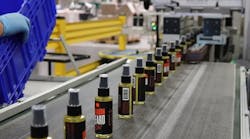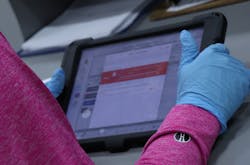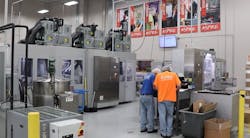Simple IIoT System Informs Lean Methodology for Body Product Manufacturer
Have you ever wondered who makes those lip balm tubes dentists ply you with in post-cleaning goody bags? Meet body product contract manufacturer Raining Rose.
“I’ve been told that the number one consumer of lip balm, which is what we make the most of, are dental offices. They consume more lip balm than any other place in the United States,” says Kyle Hach, chief operating officer.
You also may have walked past store brand lip balms, shaving creams, lotions and body washes in Target, CVS, Walgreens and Whole Foods that were also manufactured by Raining Rose in its Cedar Rapids, Iowa, plant.
The key for profitability and success in contract manufacturing is flexibility. Changeover speed is particularly important. Format adjustments, new end effectors on robots, swapping out fittings and tools and potentially full breakdowns for products like lotions or body washes add up to long periods with no product flowing from lines.
The Cedar Rapids plant features two dozen blending tanks to manufacture product, dozens of filling lines that run various sizes of tubes, blisters and containers and 20 labeling machines. Lip balm lines change over two or three times a day on average, four to five times when smaller batches run. Some labeling machines change over 40 to 50 times a day, up to 70 to 80 times when running smaller batches.
Running multiple products with constant changeovers leads to complexity that Raining Rose must track to stay compliant with FDA regulations.
Since the company’s inception, leadership has sought ways to digitize that data. It took four tries before Raining Rose found a system that reduced changeovers, increased production per hour and finally allowed the company to ditch paper-based systems.If at First You Don't Succeed with IoT…
The company’s first attempt at digitization, manually entering data from paper records into Excel spreadsheets, began in the mid-2000s. In 2013, Raining Rose added computers to a few locations on the floor and operators entered information into Microsoft Access. Only a few people had access to the data on the back end, and analyzing production proved difficult.
Next, the company tried an IoT-based system with sensors on the lines and display boards above the machines that tracked real-time performance. Operators recorded explanations for downtime events by scanning error codes printed on paper. This created visibility on the lines to track availability and performance against production targets, but only for runs in progress. And, again, only a few people had access to the back-end data.
“It was clunky to try to get weekly or monthly reporting out of it. It was just difficult to take information and analyze it, which is the whole point of having these on the lines, that you have data that you can analyze,” says Hach.
The Redzone system currently employed by Raining Rose draws data from photo eyes installed on the lines and directly from PLCs on the floor to generate counts. If PLCs do not trigger or objects do not pass the photo eye within a certain measure of time, the software registers the delay as a downtime event.
Each line has an assigned iPad. Operators annotate downtime events by selecting in the software’s dashboard preset error codes and can send the information to quality managers or maintenance techs for assistance. The operators cannot close out their shifts until accounting for every downtime event.
Operators can access captured data in the cloud from iPads and PCs. Anyone with access to the system can see in real time what’s happening with any machine. Operators can view current performance against daily targets and check the maintenance logs from preceding shifts.
The majority of employees at Raining Rose immediately bought into the system, enjoying the ease of use and clarity of information compared to earlier digitization attempts. For employees still dealing with paper-based processes, getting rid of the forms generated instant approval.
“People hate forms. And then having to remember that they have to fill out these forms. And now with this system, all that is automated. They don’t have to think about when they need to do it,” Hach says.
It took two or three months to adapt the system to the specific needs of the labeling department, however, a process that largely depended on collaboration between operators and Redzone.
Operators in the blending room prepare new batches of product for delivery to the fill lines. In the past, they only knew it was time to prepare a new batch either when they walked out to the floor and inquired or fill line operators walked to the blending room and requested more material. Newer line operators might not realize how long a job took and request new batches in a timely fashion, or someone could take a lunch break at an inopportune time and forget to inform the batch room to prepare more material, both of which led to inconsistencies.
Now, boards in the blending room display all currently running fill lines with estimated time to completion for each job. The Redzone software calculates the established performance target for the job against the total number of units to complete for that job.
“You're now relying on data to tell you how much time is left [on a fill job] versus relying on a person, hoping that they know or remember how long it was going to take them," says Hach.
Raining Rose also uses the software to prevent 'giveaway,' filling more material into a container than desired or needed. Previously, operators recorded fill weight measurements by hand.
“The ability to manage and communicate fill weight targets, along with upper and lower-level limits, was quite difficult, so the management of our fill weights and giveaway was poor," Hach says.
Now, Bluetooth scales connect to the iPads and automatically transfer weight measurement data into the Redzone software. If a measurement is either too low or too high, supervisors receive an automated notification of the failed test. For some products, Raining Rose reduced giveaway by half.
Full Data Access Means No Secrets
Anyone with access to the Redzone system can view production data from as far back as when the system first went online in 2019.
“From a manufacturing perspective, from any business perspective, what you’re trying to create is visibility and transparency throughout the organization, right? The more that people can understand how they’re performing in the job, whether they’re winning or they’re losing, typically they’re going to walk out knowing alright, I had a good day or I had a bad day, or I felt good about how I performed, or here's what I can do differently to try to perform better tomorrow,” Hach says.
The data also goes into Tableau data visualization software that generates automated reports, with a variable interface based on how Raining Rose chooses to build out and use reporting.
“We look at availability, we look at OEE, we look at labor efficiency, we look at fill weights … anybody in the organization can sign up for that report and see it at whatever cadence they want,” Hach says.
Analyzing average changeover times allows Raining Rose to set standards. When an operator clicks ”changeover” on the software UI, a 30-minute timer appears. Expectations are clear. It’s up to management to communicate to operators how the expected changeover time was arrived at, which comes down to data and tracking.
“If I’m tracking my downtime on paper, being able to trend it is almost impossible. Most companies don’t put the time or labor into keeping track of that information because it’s costly. Unless you have an incredible amount of demand on that machine and you know you need to get everything out of it, what’s driving you [to track that information], right?” says Hach.
Hach doesn’t need to go down to the floor and talk to an operator or pull paper records to see whether operators meet changeover time targets. Hach can run a report, instead.
“If the changeover happened at three in the morning, you’d be relying on that operator or that lead or supervisor communicating, ‘Hey, our changeover time was 20 minutes longer than it should have been.’ … You’re relying on that communication happening. And if they do it again the next day, and it’s 30 minutes longer than it should have been, how much are they pushing to drive that improvement?” says Hach.
Tracking the data also allows Raining Rose to observe the operators responsible for setting those expectations, watch how they conduct operations and establish best practices.
“It still takes human intervention to get that across all the shifts to make sure that they’re performing at the highest level, but the visibility and being able to pinpoint, ‘Hey, first shift is doing it really well. Let’s go understand what they’re doing differently than the others.’”
Don’t Lean on the Software
With the software up and running, changeover times reduced by half, OEE increased 20 points, and units-per-hour production increased 20%.
Hach cautions against giving credit to the software itself. Easy access to data tells a company what needs to change but not how to change it. That’s still (so far) the exclusive province of human beings.
”Software as a tool, plus using Kaizen as a lean methodology tool, those things combined, [that’s how] we were able to reduce our changeovers by 50%,” says Hach.
About the Author
Dennis Scimeca
Dennis Scimeca is a veteran technology journalist with particular experience in vision system technology, machine learning/artificial intelligence, and augmented/mixed/virtual reality (XR), with bylines in consumer, developer, and B2B outlets.
At IndustryWeek, he covers the competitive advantages gained by manufacturers that deploy proven technologies. If you would like to share your story with IndustryWeek, please contact Dennis at [email protected].



